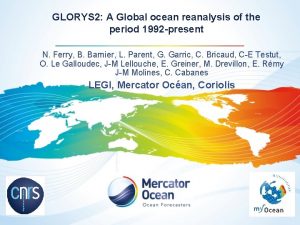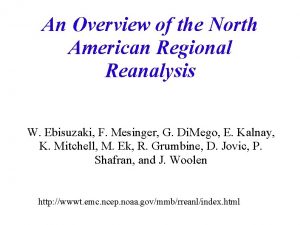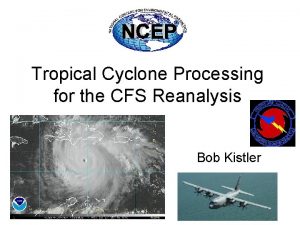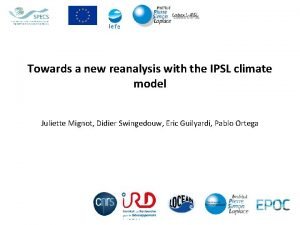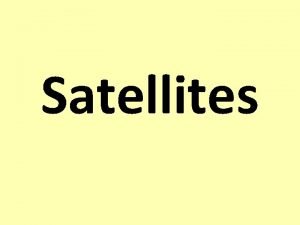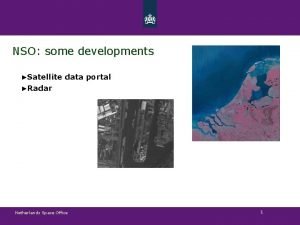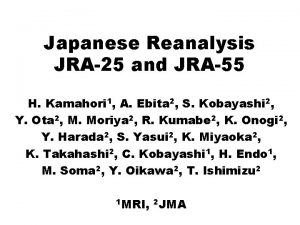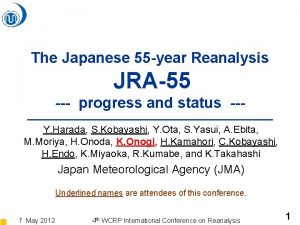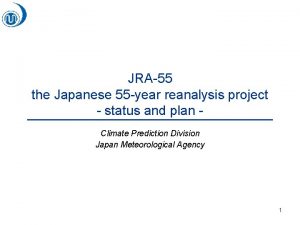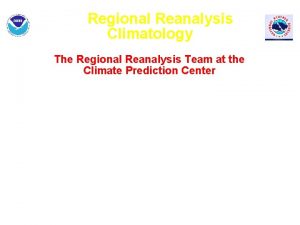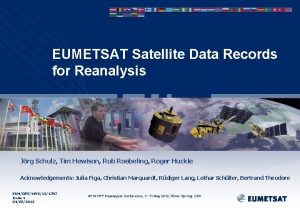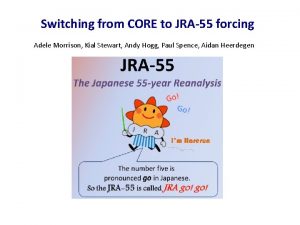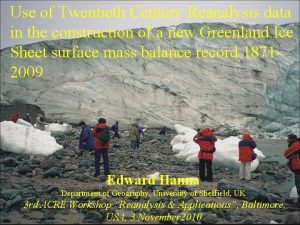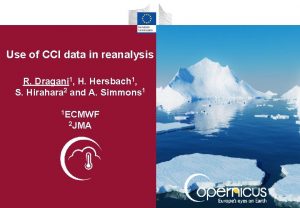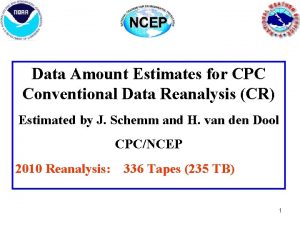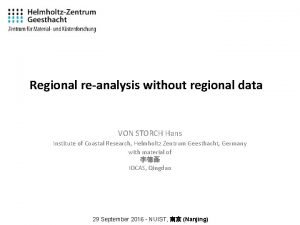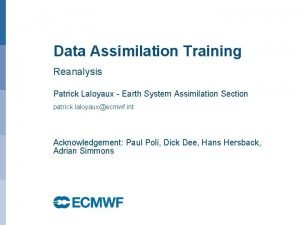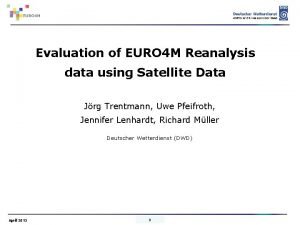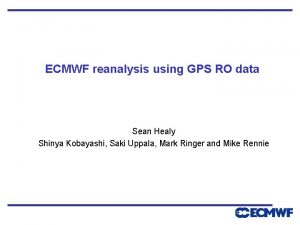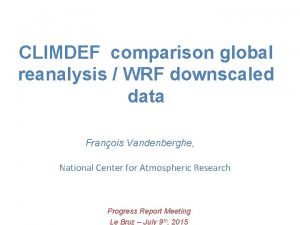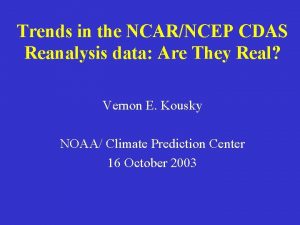Use of satellite data in the JRA55 reanalysis












![Forecast [FT=48] Scores RMSE of Z 500 for N. H. and S. H. [gpm] Forecast [FT=48] Scores RMSE of Z 500 for N. H. and S. H. [gpm]](https://slidetodoc.com/presentation_image_h/28d5ce4544b2178b6dfbce1ac7a6c6ab/image-13.jpg)
![Time-Height Cross Sections of global mean Temperature [K] anomalies in JRA and ERA reanalyses Time-Height Cross Sections of global mean Temperature [K] anomalies in JRA and ERA reanalyses](https://slidetodoc.com/presentation_image_h/28d5ce4544b2178b6dfbce1ac7a6c6ab/image-14.jpg)
![Time-Height Cross Sections of global mean Temperature [K] anomalies in JRA-55, R 1, MERRA Time-Height Cross Sections of global mean Temperature [K] anomalies in JRA-55, R 1, MERRA](https://slidetodoc.com/presentation_image_h/28d5ce4544b2178b6dfbce1ac7a6c6ab/image-15.jpg)





- Slides: 20

Use of satellite data in the JRA-55 reanalysis and related activities Y. Harada, Shinya Kobayashi, Y. Ota, H. Onoda, A. Ebita, M. Moriya, Kazutoshi Onogi, H. Kamahori, C. Kobayashi, H. Endo, K. Miyaoka, R. Kumabe, K. Takahashi, and Shotaro Tanaka CPD, Japan Meteorological Agency 2013/7/12 CGMS-41 1

Japanese Global Atmospheric Reanalysis 1 st JRA-25 By JMA and CRIEPI (1979~2004) (Central Research Institute for Electric Power Industry) 2 nd JRA-55 ( JRA Go! ) By JMA (1958~2012) JRA-55 is the first reanalysis which covers more than 50 years since 1958 with 4 D-var data assimilation system. 2

JRA-55 Reanalysis system JRA-25 JRA-55 Reanalysis years 1979 -2004 (26 years) 1958 -2012 (55 years) Equivalent operational NWP system As of Mar. 2004 As of Dec. 2009 Resolution T 106 L 40 (~110 km) (top layer at 0. 4 h. Pa) TL 319 L 60 (~55 km) (top layer at 0. 1 h. Pa) Time integration Eularian Semi-Lagrangian Assimilation scheme 3 D-Var 4 D-Var (with T 106 inner model) Bias correction (satellite radiance) Adaptive method (Sakamoto et al. 2009) Variational Bias Correction (Dee et al. 2009) GHG concentrations Constant at 375 ppmv (CO 2) Annual mean data are interpolated to daily data (CO 2, CH 4, N 2 O) 3

Observational Data available for JRA-55 GNSS: Global Navigation Satellite System 4

Number of observations assimilated (Global) logarithmic scale Lower coverage in TOVS 3 METEOSAT FGGE ATOVS METEOSAT(Indian Ocean) 5

Reprocess of geostationary satellite data for reanalysis 6

Available Reprocessed AMV and CSR data Expanding yellow part in the obs. data table CSR AMV Thick line : reprocessed period 7

Impossible to reprocess Still used in reanalyses Height assignment of Operational AMVs used in ERA-15 (ERA-15 Report 3, Uppala, 1997) University of Wisconsin has a plan to reprocess GOES AMVs. Impossible to reprocess Still used in reanalyses Replaced by reprocessed AMV ßUsually at 200 h. Pa but sometimes changed ßAlways at 850 h. Pa Still used in reanalyses ßVery small amount of data ßAlways at 850 h. Pa 8

Reprocess of Japanese geostationary satellites data by MSC/JMA • MSC of JMA reprocessed 2 times for the JRA reanalyses. • 1 st Reprocessed AMVs for JRA-25 – GMS-3, 4, and 5. • 2 nd Newly reprocessed AMVs and CSRs for JRA -55 – – – GMS-1(1979 only), 3, 4, 5, GOES-9, and MTSAT-1 R As a pilot project of SCOPE-CM JRA-25 reanalysis was used as a reference. QI is allocated for each AMV. Expansion of derivation area (from 50 S-50 N to 60 S-60 N). Quality has been improved. 9

2 nd reprocess by MSC for JRA-55 MSC/JMA has been computing AMVs from the past satellites (GMS, GOES-9 and MTSAT-1 R between 1979 and 2009) using the latest AMV derivation algorithms. The data set of AMVs is provided for JRA-55 and SCOPE-CM. Main quality difference for JRA-55 for JRA-25 (New reprocess) (Previous reprocess) between the previous reprocess (for JRA-25) and the new reprocess (for JRA-55). l. Expansion of derivation area (from 50 S-50 N to 60 S-60 N). l. Mitigation of slow wind speed bias in the winter hemisphere, owing to the improvement of height assignment scheme and resizing target box size. Wind speed bias (QI>0. 85) of high-level IR-AMVs to JRA-25 analysis fields (Jan. 1990, GMS-4) 6 Meteorological Satellite Center Technical Note, No. 54 Information website: http: //mscweb. kishou. go. jp/product/reprocess/index. htm Oyama(2010) 10

Performance of JRA-55 11

Isentropic Potential Vorticity (at 360 K) 1 June 1983 00 UTC – 6 June 1983 00 UTC JRA-55 (4 D-var) JRA-25 (3 D-var) 12
![Forecast FT48 Scores RMSE of Z 500 for N H and S H gpm Forecast [FT=48] Scores RMSE of Z 500 for N. H. and S. H. [gpm]](https://slidetodoc.com/presentation_image_h/28d5ce4544b2178b6dfbce1ac7a6c6ab/image-13.jpg)
Forecast [FT=48] Scores RMSE of Z 500 for N. H. and S. H. [gpm] N. H. JRA-55 JRA-25 Year S. H. Operation Lower spatial coverage in TOVS VTPR TOVS Year ATOVS 13
![TimeHeight Cross Sections of global mean Temperature K anomalies in JRA and ERA reanalyses Time-Height Cross Sections of global mean Temperature [K] anomalies in JRA and ERA reanalyses](https://slidetodoc.com/presentation_image_h/28d5ce4544b2178b6dfbce1ac7a6c6ab/image-14.jpg)
Time-Height Cross Sections of global mean Temperature [K] anomalies in JRA and ERA reanalyses JRA-55 JRA-25 (h. Pa) (Year) ERA-40 ERA-Interim (h. Pa) (Year) Anomalies from the mean temperature at each pressure level for years 1980 to 2001 of each reanalysis, JRA-55, ERA-40, JRA-25 and ERA-Interim , respectively. 14
![TimeHeight Cross Sections of global mean Temperature K anomalies in JRA55 R 1 MERRA Time-Height Cross Sections of global mean Temperature [K] anomalies in JRA-55, R 1, MERRA](https://slidetodoc.com/presentation_image_h/28d5ce4544b2178b6dfbce1ac7a6c6ab/image-15.jpg)
Time-Height Cross Sections of global mean Temperature [K] anomalies in JRA-55, R 1, MERRA and CFSR JRA-55 MERRA (NASA GMAO) (h. Pa) (Year) NCEP/NCAR R 1 CFSR (NCEP) (h. Pa) (Year) 15

Summary and plan of JRA-55 • Observational Data for JRA-55 – Improvement in both quality and quantity from JRA-25 • Many reprocessed Satellite Data • Newly available data • Validation of JRA-55 – JRA-55 has much better quality than JRA-25. – Less unnatural gaps than other reanalyses • Autumn 2013 – JRA-55 products will be released for research use. – The data will be available from JMA, DIAS… • Comprehensive reports are in preparation. 9. 5 16

Use of satellite data in JMA’s operational Climate Monitoring Services (Related activities) • CPD of JMA operates climate monitoring services. – JRA reanalysis data are basic climate data. – Anomalies from JRA climate are evaluated. – Satellite data contribute to improve reanalysis quality. • Satellite data are directly used as well. – Convection active area (OLR) – Snow coverage (SSM/I, SSMIS) 17

Satellite data used in JMA’s climate monitoring OLR(Outgoing Long-wave Radiation) Analysis Anomaly 18

Satellite data used in JMA’s climate monitoring Snow covered days analyzed from SSM/I & SSMIS data 12 http: //www. data. jma. go. jp/gmd/cpd/db/diag/db_hist_mon. html 19

Thank you for your attention 20
 Glorys reanalysis
Glorys reanalysis North american regional reanalysis
North american regional reanalysis Tcvitals
Tcvitals Reanalysis
Reanalysis Polar satellites
Polar satellites Nso satellite office
Nso satellite office Hình ảnh bộ gõ cơ thể búng tay
Hình ảnh bộ gõ cơ thể búng tay Ng-html
Ng-html Bổ thể
Bổ thể Tỉ lệ cơ thể trẻ em
Tỉ lệ cơ thể trẻ em Voi kéo gỗ như thế nào
Voi kéo gỗ như thế nào Tư thế worm breton là gì
Tư thế worm breton là gì Chúa yêu trần thế alleluia
Chúa yêu trần thế alleluia Kể tên các môn thể thao
Kể tên các môn thể thao Thế nào là hệ số cao nhất
Thế nào là hệ số cao nhất Các châu lục và đại dương trên thế giới
Các châu lục và đại dương trên thế giới Cong thức tính động năng
Cong thức tính động năng Trời xanh đây là của chúng ta thể thơ
Trời xanh đây là của chúng ta thể thơ Cách giải mật thư tọa độ
Cách giải mật thư tọa độ Làm thế nào để 102-1=99
Làm thế nào để 102-1=99 Phản ứng thế ankan
Phản ứng thế ankan
